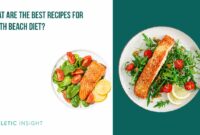South Beach Diet success stories are abundant, showcasing its effectiveness for weight loss and improved health. This comprehensive guide delves into the diet’s core principles, outlining its phased approach and providing sample meal plans. We’ll explore real-life testimonials, compare its efficacy to other popular diets, and discuss its long-term sustainability. We’ll also address potential challenges and offer practical strategies to overcome them, ensuring your journey towards a healthier lifestyle is both informed and successful.
From understanding the dietary restrictions of each phase to discovering practical tips for maintaining long-term adherence, this guide provides a holistic overview. We’ll examine the potential health benefits, such as improved blood sugar control and reduced inflammation, while also acknowledging potential risks and side effects. By comparing the South Beach Diet to other popular options, including the Mediterranean Diet, we aim to provide a clear and balanced perspective, empowering you to make informed decisions about your health and well-being.
Diet Plan Overview
The South Beach Diet is a low-carbohydrate diet designed for weight loss and improved health. It differs from other low-carb diets by its emphasis on healthy fats and the types of carbohydrates allowed. The core principle revolves around minimizing the intake of simple carbohydrates and refined sugars while emphasizing the consumption of complex carbohydrates, lean proteins, and healthy fats. This approach aims to stabilize blood sugar levels, reduce insulin resistance, and promote sustainable weight management.
The diet is structured into three phases, each with progressively less restrictive guidelines. Understanding these phases is key to successfully navigating the South Beach Diet.
Phases of the South Beach Diet
The South Beach Diet progresses through three distinct phases: Phase 1, Phase 2, and Phase 3. Each phase introduces different levels of carbohydrate restriction and expands the range of permissible foods. Careful adherence to each phase’s guidelines is essential for achieving optimal results.
Phase 1: The First Two Weeks
This initial phase is the most restrictive. It eliminates most simple carbohydrates, such as white bread, pastries, sugary drinks, and processed foods. The focus is on lean protein, healthy fats, and non-starchy vegetables. This helps to curb cravings, stabilize blood sugar, and jumpstart weight loss.
| Food | Calories (approx.) | Macronutrients (approx.) | Notes |
|---|---|---|---|
| Grilled Salmon with Asparagus | 450 | Protein: 35g, Fat: 25g, Carbs: 10g | Choose wild-caught salmon for optimal omega-3 fatty acids. |
| Chicken Salad (with avocado and mixed greens) | 380 | Protein: 30g, Fat: 20g, Carbs: 5g | Use a light vinaigrette dressing. |
| Steak with Broccoli and Cauliflower | 500 | Protein: 40g, Fat: 30g, Carbs: 10g | Lean cuts of steak are preferred. |
| Egg Omelet with Spinach and Mushrooms | 250 | Protein: 20g, Fat: 15g, Carbs: 5g | Use whole eggs. |
Phase 2: Transition Phase
Once initial weight loss is achieved (typically after two weeks), the diet transitions to Phase 2. This phase gradually reintroduces some healthy carbohydrates, such as whole grains, fruits, and legumes, while maintaining restrictions on less healthy carbohydrate choices. The goal is to find a sustainable balance and prevent weight regain.
| Food | Calories (approx.) | Macronutrients (approx.) | Notes |
|---|---|---|---|
| Quinoa Salad with Grilled Chicken and Vegetables | 400 | Protein: 30g, Fat: 15g, Carbs: 40g | Choose a variety of colorful vegetables. |
| Lentil Soup with a whole-wheat roll | 350 | Protein: 25g, Fat: 10g, Carbs: 45g | Limit the roll to a small portion. |
| Baked Chicken Breast with Brown Rice and Steamed Green Beans | 450 | Protein: 35g, Fat: 15g, Carbs: 50g | Use brown rice instead of white rice. |
| Turkey Meatloaf with Sweet Potato | 500 | Protein: 40g, Fat: 20g, Carbs: 55g | Use lean ground turkey. |
Phase 3: Lifetime Maintenance
This is the final and ongoing phase. It focuses on maintaining a healthy weight and lifestyle. The diet continues to emphasize healthy choices but allows for more flexibility and the occasional indulgence of less healthy foods in moderation. The key is mindful eating and maintaining healthy habits established in the previous phases.
| Food | Calories (approx.) | Macronutrients (approx.) | Notes |
|---|---|---|---|
| Chicken Stir-fry with Brown Rice Noodles | 550 | Protein: 40g, Fat: 20g, Carbs: 60g | Use a low-sodium soy sauce. |
| Salmon with Roasted Vegetables and a small portion of whole-wheat pasta | 600 | Protein: 45g, Fat: 25g, Carbs: 70g | Enjoy a small portion of pasta. |
| Lean Beef with Sweet Potato and Asparagus | 500 | Protein: 40g, Fat: 20g, Carbs: 50g | Control portion sizes. |
| Vegetarian Chili with a side salad | 400 | Protein: 20g, Fat: 15g, Carbs: 55g | Use plenty of vegetables. |
Weight Loss Results
The South Beach Diet’s success hinges on its ability to deliver noticeable and sustainable weight loss. Many individuals report significant reductions in body weight, often accompanied by improvements in overall health markers. The diet’s phased approach, focusing on healthy food choices and controlled carbohydrate intake, contributes to its effectiveness.
Weight loss on the South Beach Diet varies depending on individual factors such as starting weight, adherence to the plan, and activity level. However, consistent results are frequently reported.
Individual Success Stories
The South Beach Diet website and various online forums showcase numerous testimonials from individuals who have achieved significant weight loss. For example, one individual reported losing 25 pounds in three months by strictly following the diet’s guidelines and incorporating regular exercise. Another participant, initially struggling with high blood pressure, documented a 15-pound weight loss and a significant drop in their blood pressure readings after six months on the South Beach Diet. These anecdotal accounts highlight the potential for substantial weight loss with commitment to the program. These experiences, while individual, illustrate the diet’s potential for impacting weight and related health conditions.
Typical Weight Loss Range
While individual results vary, many individuals following the South Beach Diet report losing 1-2 pounds per week. This gradual weight loss is often considered healthier and more sustainable than rapid weight loss methods. Factors influencing the rate of weight loss include initial body weight, metabolism, activity level, and adherence to the diet’s principles. Those starting with a higher BMI may see more significant initial weight loss.
Comparison with Other Popular Diets
Understanding how the South Beach Diet compares to other popular weight-loss approaches provides valuable context. The following table offers a comparison, acknowledging that individual results will always vary:
| Diet | Typical Weight Loss (per week) | Time to See Results | Potential Side Effects |
|---|---|---|---|
| South Beach Diet | 1-2 pounds | 1-2 weeks | Mild initial headaches, fatigue (usually subsides) |
| Ketogenic Diet | 1-3 pounds (initial), then slows | 1-2 weeks | “Keto flu” (headache, fatigue, nausea), constipation, nutrient deficiencies |
| Intermittent Fasting | Varies widely, depends on fasting protocol | 1-4 weeks | Hunger, fatigue, dizziness, irritability, potential for disordered eating |
Health Benefits and Risks
The South Beach Diet, while promising weight loss, presents both potential health advantages and drawbacks. Understanding these aspects is crucial for making an informed decision about whether this dietary approach is suitable for individual needs and health conditions. A balanced perspective considering both benefits and risks is essential.
The South Beach Diet’s emphasis on limiting refined carbohydrates and prioritizing healthy fats and lean proteins can lead to several positive health outcomes. However, it’s important to be aware of potential downsides and to consult with a healthcare professional before starting any new diet.
Improved Blood Sugar Control
The South Beach Diet’s initial phase restricts refined carbohydrates, which are rapidly digested and cause spikes in blood sugar. By limiting these foods, the diet can help improve insulin sensitivity and regulate blood glucose levels. This is particularly beneficial for individuals with prediabetes or type 2 diabetes, as it can help manage their condition and potentially reduce the risk of developing more serious complications. For example, studies have shown that low-carbohydrate diets, similar in principle to the South Beach Diet, can significantly improve HbA1c levels, a key indicator of long-term blood sugar control.
Reduced Inflammation
The diet’s focus on whole, unprocessed foods, including fruits, vegetables, and lean proteins, provides an abundance of antioxidants and anti-inflammatory compounds. These nutrients combat oxidative stress and chronic inflammation, which are linked to various health problems such as heart disease, arthritis, and certain types of cancer. The reduction in refined carbohydrates and processed foods also contributes to decreased inflammation, as these foods can trigger inflammatory responses in the body. A diet rich in anti-inflammatory foods, as encouraged by the South Beach Diet, can contribute to overall improved well-being.
Potential Nutrient Deficiencies
Restrictive diets, like the South Beach Diet, can potentially lead to nutrient deficiencies if not carefully planned. The initial phase’s limitations on certain food groups may restrict the intake of essential vitamins and minerals. For instance, insufficient intake of fruits and vegetables in later phases could result in a deficiency of vitamins A and C. Careful meal planning and potential supplementation, guided by a registered dietitian or healthcare professional, are crucial to mitigate this risk.
Digestive Issues
A sudden and significant change in dietary habits, as seen in the South Beach Diet, may cause digestive disturbances in some individuals. These issues can include constipation, diarrhea, bloating, and gas. This is often due to the body adjusting to the altered intake of fiber and other nutrients. Gradually transitioning to the diet and increasing fiber intake gradually can help minimize these digestive problems. Paying attention to individual tolerance and adjusting the diet accordingly is vital.
Infographic Description
Imagine an infographic split into two halves, one titled “Benefits” and the other “Risks”.
Benefits Side: This side features a vibrant image of fresh, healthy foods like salmon, vegetables, and berries. Three key benefits are illustrated with icons:
1. Blood Sugar Control: An icon of a stable blood sugar graph alongside text explaining improved insulin sensitivity and regulated blood glucose levels.
2. Reduced Inflammation: An icon depicting a healthy cell alongside text explaining the role of antioxidants and anti-inflammatory compounds in combating oxidative stress.
3. Weight Loss: An icon of a person achieving their weight goal, paired with text mentioning the potential for weight management due to the controlled carbohydrate intake.
Risks Side: This side uses a more muted color palette and shows an image representing potential digestive discomfort. Three key risks are illustrated with icons:
1. Nutrient Deficiencies: An icon depicting a person with a worried expression, paired with text warning about the potential lack of essential vitamins and minerals if not carefully planned.
2. Digestive Issues: An icon of an upset stomach, alongside text explaining potential digestive disturbances like bloating and constipation.
3. Unsustainability: An icon representing a person struggling to maintain the diet long-term, paired with text emphasizing the importance of long-term dietary sustainability. This section highlights the potential difficulty of adhering to strict dietary limitations over an extended period.
Long-Term Sustainability
The South Beach Diet, while effective for initial weight loss, hinges on its long-term sustainability for achieving lasting results. Successfully transitioning from the structured phases to a flexible, balanced lifestyle is key to preventing weight regain and maintaining the health benefits achieved. This requires a gradual shift in focus from strict adherence to the diet’s rules to a mindful approach to food choices informed by the diet’s core principles.
The South Beach Diet’s success in the long term relies less on rigid adherence to specific phases and more on the adoption of its core principles into a sustainable eating pattern. These principles, emphasizing whole, unprocessed foods, moderate carbohydrate intake, and healthy fats, can be adapted to fit various lifestyles and preferences. The key is to understand the underlying rationale behind the diet’s restrictions and to apply this knowledge to make informed food choices consistently.
Transitioning to a Flexible Eating Plan
Successfully transitioning from the structured phases of the South Beach Diet to a more flexible approach requires a phased and gradual process. Beginning with the final phase of the diet, individuals can slowly introduce previously restricted foods, paying close attention to how their body responds. This mindful approach allows for personal adjustments and prevents sudden weight fluctuations. For example, someone might start by incorporating a small portion of whole-grain bread once a week and gradually increase the frequency or portion size based on their weight and energy levels. Regular monitoring of weight and overall health indicators, such as blood pressure and cholesterol levels, provides crucial feedback to guide this transition.
Incorporating South Beach Principles into a Balanced Lifestyle
Maintaining weight loss long-term requires integrating the South Beach Diet’s principles into a balanced lifestyle. This means making conscious food choices that align with the diet’s emphasis on whole, unprocessed foods, lean protein, and healthy fats. Prioritizing regular physical activity is equally crucial, not just for weight management but also for overall health and well-being. For instance, incorporating regular walks, swimming, or cycling into one’s routine can significantly contribute to long-term weight maintenance. Moreover, mindful eating practices, such as paying attention to hunger and fullness cues, can prevent overeating and support sustainable weight management. Regular meal planning and preparation can also help ensure consistent adherence to a healthy eating pattern. For example, preparing lunches and dinners in advance can prevent impulsive, unhealthy food choices when time is limited.
Comparison with Other Diets
Choosing a diet can feel overwhelming, given the sheer number of options available. Understanding the similarities and differences between various approaches is crucial for making an informed decision. This section compares the South Beach Diet with the widely-regarded Mediterranean Diet, highlighting their strengths and weaknesses.
The South Beach Diet and the Mediterranean Diet, while distinct, share some common ground in their emphasis on whole, unprocessed foods. Both encourage the consumption of fruits, vegetables, and lean protein sources. However, their approaches to carbohydrates and specific food groups differ significantly, leading to varied outcomes and suitability for different individuals.
South Beach Diet versus Mediterranean Diet: Food Choices
The South Beach Diet initially restricts carbohydrates, particularly refined sugars and processed grains, while emphasizing healthy fats and lean proteins. This initial phase aims for rapid weight loss by inducing ketosis. Subsequently, the diet gradually reintroduces some carbohydrates, prioritizing those with a lower glycemic index. The Mediterranean Diet, conversely, focuses on a balanced intake of carbohydrates, primarily from whole grains, fruits, and vegetables, alongside healthy fats from olive oil and nuts, and lean proteins from fish and poultry. It generally does not severely restrict carbohydrate intake. The South Beach Diet might include foods like grilled chicken with asparagus and avocado, while a Mediterranean meal might consist of grilled salmon with roasted vegetables and quinoa.
South Beach Diet versus Mediterranean Diet: Ease of Adherence and Long-Term Sustainability
The South Beach Diet’s initial restrictive phase can be challenging for some individuals to maintain long-term due to its carbohydrate limitations. This can lead to feelings of deprivation and potential difficulties in social situations. The Mediterranean Diet, with its less restrictive nature and emphasis on enjoyable, flavorful meals, tends to be easier to adhere to over the long term. Its focus on lifestyle changes rather than strict rules fosters a more sustainable approach to healthy eating.
South Beach Diet versus Mediterranean Diet: Potential Health Impacts
Both diets have been associated with positive health outcomes, including weight loss, improved blood sugar control, and reduced risk of cardiovascular disease. However, the mechanisms differ. The South Beach Diet’s initial emphasis on ketosis can lead to rapid weight loss, but long-term sustainability may be an issue for some. The Mediterranean Diet’s focus on a balanced nutrient intake and overall lifestyle modifications contributes to sustained weight management and improved overall health markers over the long term. Studies have shown the Mediterranean Diet’s positive impact on various chronic diseases, including heart disease and type 2 diabetes. The South Beach Diet, while showing weight loss benefits, requires more research to fully understand its long-term effects on various health parameters.
Summary of Key Differences and Similarities
The following bullet points summarize the key distinctions and commonalities between the South Beach Diet and the Mediterranean Diet:
- Similarities: Both diets emphasize whole, unprocessed foods, lean proteins, and healthy fats. Both aim for weight loss and improved health markers.
- Differences: The South Beach Diet initially restricts carbohydrates, while the Mediterranean Diet incorporates a balanced intake of carbohydrates. The South Beach Diet might lead to rapid initial weight loss, but the Mediterranean Diet is often considered more sustainable in the long run. The Mediterranean Diet has more extensive research supporting its long-term health benefits.
Recipes and Meal Ideas
The South Beach Diet emphasizes whole, unprocessed foods, lean protein, and healthy fats. Successfully following the diet requires understanding how to prepare delicious and satisfying meals within its guidelines. This section provides sample recipes and tips for creating your own South Beach-friendly meals.
South Beach Diet Recipes
The following recipes demonstrate the versatility of the South Beach Diet. They are designed to be both delicious and nutritionally balanced, fitting within the dietary phases. Remember to adjust portion sizes to meet your individual caloric needs.
| Ingredient | Quantity | Instructions | Nutritional Information (per serving, approximate) |
|---|---|---|---|
| Salmon Fillet | 6 oz | Season with salt, pepper, and dill. Bake at 400°F (200°C) for 12-15 minutes, or until cooked through. | Calories: 200-250; Protein: 25-30g; Fat: 10-15g |
| Asparagus | 1 bunch | Toss with olive oil, salt, and pepper. Roast alongside the salmon for the last 10 minutes. | Calories: 40-50; Protein: 3-4g; Fat: 2-3g |
| Quinoa | 1/2 cup cooked | Cook according to package directions. Serve as a side dish. | Calories: 110-120; Protein: 4-5g; Fat: 2g |
| Ingredient | Quantity | Instructions | Nutritional Information (per serving, approximate) |
|---|---|---|---|
| Ground Turkey | 1 lb | Brown ground turkey in a pan. Drain excess fat. | Calories: 200-250; Protein: 25-30g; Fat: 10-15g |
| Bell Peppers (various colors) | 1 each | Chop bell peppers into bite-sized pieces. | Calories: 20-30; Protein: 1g; Fat: 1g |
| Onion | 1/2 | Chop onion and sauté with bell peppers until softened. | Calories: 20-30; Protein: 1g; Fat: 1g |
| Spinach | 1 cup | Add spinach to the pan and wilt. | Calories: 7; Protein: 1g; Fat: 0g |
| Seasoning (cumin, chili powder) | to taste | Add seasoning to taste. | Calories: Negligible |
| Ingredient | Quantity | Instructions | Nutritional Information (per serving, approximate) |
|---|---|---|---|
| Chicken Breast | 6 oz | Grill or bake chicken breast until cooked through. | Calories: 150-200; Protein: 30-35g; Fat: 3-5g |
| Broccoli | 1 cup florets | Steam or microwave broccoli until tender-crisp. | Calories: 50-60; Protein: 4-5g; Fat: 1g |
| Avocado | 1/4 | Slice avocado and serve as a topping. | Calories: 80-100; Protein: 2g; Fat: 7-9g |
| Lemon Juice | 1 tbsp | Squeeze lemon juice over chicken and broccoli. | Calories: 3 |
Tips for Delicious South Beach Meals
Experiment with herbs and spices to add flavor without relying on salt or sugar. Utilize healthy fats like olive oil, avocado oil, and nuts/seeds to enhance satiety and flavor. Prioritize lean protein sources such as fish, chicken breast, turkey, and beans. Plenty of non-starchy vegetables should form the base of most meals. Plan your meals in advance to avoid impulsive unhealthy choices. Don’t be afraid to try new recipes and find what you enjoy. Remember that consistency is key to long-term success.
Final Summary
Ultimately, South Beach Diet success hinges on a personalized approach that considers individual needs and preferences. While the structured phases provide a solid framework, long-term success relies on adapting the diet’s principles to create a sustainable, balanced lifestyle. By understanding the potential benefits and risks, addressing common challenges proactively, and seeking support when needed, you can significantly increase your chances of achieving and maintaining your health goals. Remember, consistency and a positive mindset are key components in this transformative journey.




